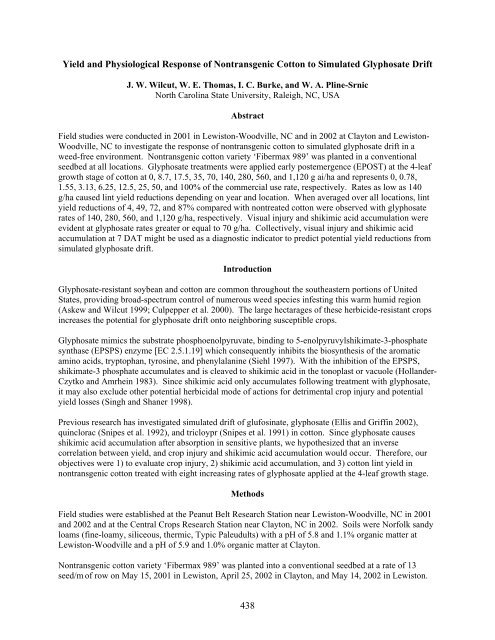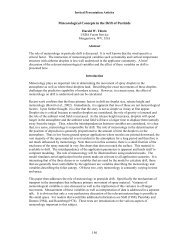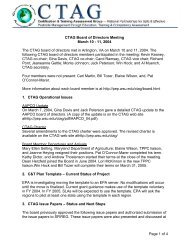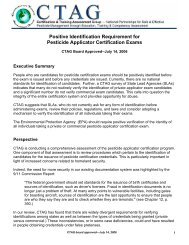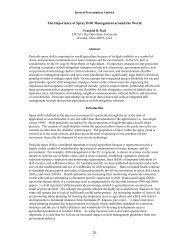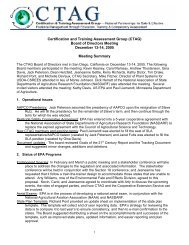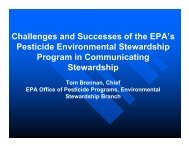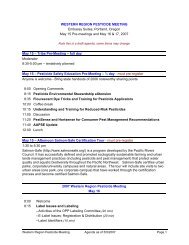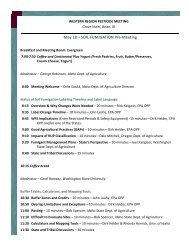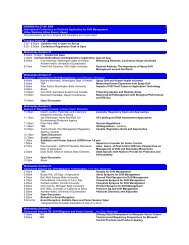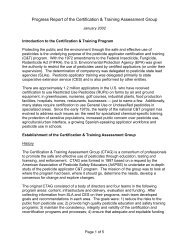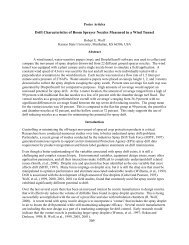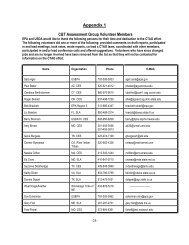438 Yield and Physiological Response of Nontransgenic Cotton to ...
438 Yield and Physiological Response of Nontransgenic Cotton to ...
438 Yield and Physiological Response of Nontransgenic Cotton to ...
Create successful ePaper yourself
Turn your PDF publications into a flip-book with our unique Google optimized e-Paper software.
<strong>Yield</strong> <strong>and</strong> <strong>Physiological</strong> <strong>Response</strong> <strong>of</strong> <strong>Nontransgenic</strong> <strong>Cot<strong>to</strong>n</strong> <strong>to</strong> Simulated Glyphosate DriftJ. W. Wilcut, W. E. Thomas, I. C. Burke, <strong>and</strong> W. A. Pline-SrnicNorth Carolina State University, Raleigh, NC, USAAbstractField studies were conducted in 2001 in Lewis<strong>to</strong>n-Woodville, NC <strong>and</strong> in 2002 at Clay<strong>to</strong>n <strong>and</strong> Lewis<strong>to</strong>n-Woodville, NC <strong>to</strong> investigate the response <strong>of</strong> nontransgenic cot<strong>to</strong>n <strong>to</strong> simulated glyphosate drift in aweed-free environment. <strong>Nontransgenic</strong> cot<strong>to</strong>n variety ‘Fibermax 989’ was planted in a conventionalseedbed at all locations. Glyphosate treatments were applied early postemergence (EPOST) at the 4-leafgrowth stage <strong>of</strong> cot<strong>to</strong>n at 0, 8.7, 17.5, 35, 70, 140, 280, 560, <strong>and</strong> 1,120 g ai/ha <strong>and</strong> represents 0, 0.78,1.55, 3.13, 6.25, 12.5, 25, 50, <strong>and</strong> 100% <strong>of</strong> the commercial use rate, respectively. Rates as low as 140g/ha caused lint yield reductions depending on year <strong>and</strong> location. When averaged over all locations, lintyield reductions <strong>of</strong> 4, 49, 72, <strong>and</strong> 87% compared with nontreated cot<strong>to</strong>n were observed with glyphosaterates <strong>of</strong> 140, 280, 560, <strong>and</strong> 1,120 g/ha, respectively. Visual injury <strong>and</strong> shikimic acid accumulation wereevident at glyphosate rates greater or equal <strong>to</strong> 70 g/ha. Collectively, visual injury <strong>and</strong> shikimic acidaccumulation at 7 DAT might be used as a diagnostic indica<strong>to</strong>r <strong>to</strong> predict potential yield reductions fromsimulated glyphosate drift.IntroductionGlyphosate-resistant soybean <strong>and</strong> cot<strong>to</strong>n are common throughout the southeastern portions <strong>of</strong> UnitedStates, providing broad-spectrum control <strong>of</strong> numerous weed species infesting this warm humid region(Askew <strong>and</strong> Wilcut 1999; Culpepper et al. 2000). The large hectarages <strong>of</strong> these herbicide-resistant cropsincreases the potential for glyphosate drift on<strong>to</strong> neighboring susceptible crops.Glyphosate mimics the substrate phosphoenolpyruvate, binding <strong>to</strong> 5-enolpyruvylshikimate-3-phosphatesynthase (EPSPS) enzyme [EC 2.5.1.19] which consequently inhibits the biosynthesis <strong>of</strong> the aromaticamino acids, tryp<strong>to</strong>phan, tyrosine, <strong>and</strong> phenylalanine (Siehl 1997). With the inhibition <strong>of</strong> the EPSPS,shikimate-3 phosphate accumulates <strong>and</strong> is cleaved <strong>to</strong> shikimic acid in the <strong>to</strong>noplast or vacuole (Holl<strong>and</strong>er-Czytko <strong>and</strong> Amrhein 1983). Since shikimic acid only accumulates following treatment with glyphosate,it may also exclude other potential herbicidal mode <strong>of</strong> actions for detrimental crop injury <strong>and</strong> potentialyield losses (Singh <strong>and</strong> Shaner 1998).Previous research has investigated simulated drift <strong>of</strong> glufosinate, glyphosate (Ellis <strong>and</strong> Griffin 2002),quinclorac (Snipes et al. 1992), <strong>and</strong> tricloypr (Snipes et al. 1991) in cot<strong>to</strong>n. Since glyphosate causesshikimic acid accumulation after absorption in sensitive plants, we hypothesized that an inversecorrelation between yield, <strong>and</strong> crop injury <strong>and</strong> shikimic acid accumulation would occur. Therefore, ourobjectives were 1) <strong>to</strong> evaluate crop injury, 2) shikimic acid accumulation, <strong>and</strong> 3) cot<strong>to</strong>n lint yield innontransgenic cot<strong>to</strong>n treated with eight increasing rates <strong>of</strong> glyphosate applied at the 4-leaf growth stage.MethodsField studies were established at the Peanut Belt Research Station near Lewis<strong>to</strong>n-Woodville, NC in 2001<strong>and</strong> 2002 <strong>and</strong> at the Central Crops Research Station near Clay<strong>to</strong>n, NC in 2002. Soils were Norfolk s<strong>and</strong>yloams (fine-loamy, siliceous, thermic, Typic Paleudults) with a pH <strong>of</strong> 5.8 <strong>and</strong> 1.1% organic matter atLewis<strong>to</strong>n-Woodville <strong>and</strong> a pH <strong>of</strong> 5.9 <strong>and</strong> 1.0% organic matter at Clay<strong>to</strong>n.<strong>Nontransgenic</strong> cot<strong>to</strong>n variety ‘Fibermax 989’ was planted in<strong>to</strong> a conventional seedbed at a rate <strong>of</strong> 13seed/m <strong>of</strong> row on May 15, 2001 in Lewis<strong>to</strong>n, April 25, 2002 in Clay<strong>to</strong>n, <strong>and</strong> May 14, 2002 in Lewis<strong>to</strong>n.<strong>438</strong>
<strong>Cot<strong>to</strong>n</strong> was seeded in 96 cm <strong>and</strong> 91 cm row spacing in Clay<strong>to</strong>n <strong>and</strong> Lewis<strong>to</strong>n, respectively, with a plotlength <strong>of</strong> 6.1 m <strong>and</strong> 4 rows wide. Pendimethalin at 0.84 kg ai/ha <strong>and</strong> fluometuron at 1.12 kg ai/ha wereapplied preemergence (PRE) on the day <strong>of</strong> planting at each location. An EPOST treatment <strong>of</strong> glyphosatewas applied <strong>to</strong> cot<strong>to</strong>n at the 4-leaf growth stage <strong>to</strong> the center two rows <strong>of</strong> each plot. Glyphosate ratesincluded 0, 8.7, 17.5, 35, 70, 140, 280, 560, <strong>and</strong> 1,120 g ai/ha <strong>and</strong> represent 0, 0.78, 1.55, 3.13, 6.25, 12.5,25, 50, <strong>and</strong> 100% <strong>of</strong> the commercial use rate, respectively. A late postemergence-directed (PDS)application <strong>of</strong> prometryn at 1.12 kg ai/ha plus MSMA at 2.24 kg ai/ha plus a non-ionic surfactant at0.25% (v/v) followed by a late POST application <strong>of</strong> clethodim at 140 g ai/ha plus 1.0% (v/v) crop oilconcentrate was applied <strong>to</strong> all plots <strong>to</strong> control weeds. All plots received biweekly h<strong>and</strong> weeding <strong>to</strong>maintain a weed-free environment through harvest.Visual estimates <strong>of</strong> cot<strong>to</strong>n injury based on a summation <strong>of</strong> stunting, discoloration, <strong>and</strong> st<strong>and</strong> reductionranged from 0 (no injury) <strong>to</strong> 100 (plant death) (Frans et al. 1986). <strong>Cot<strong>to</strong>n</strong> injury was recorded 7 d afterthe EPOST treatment (DAT) at all locations. The center two rows <strong>of</strong> each plot were harvested once witha spindle picker modified for small plot research.Shikimic Acid Accumulation. A modified spectropho<strong>to</strong>metric method for detection <strong>of</strong> shikimic acidwas used due <strong>to</strong> the relative simplicity <strong>of</strong> the labora<strong>to</strong>ry procedures compared <strong>to</strong> HPLC detection methods(Pline et al. 2002; Singh <strong>and</strong> Shaner 1998). The spectropho<strong>to</strong>metric method has been shown <strong>to</strong> becomeless efficient at higher shikimic acid concentrations, but plants exhibiting these high accumulation valuesresulting from high rates <strong>of</strong> glyphosate are most <strong>of</strong>ten killed (Pline et al. 2002). One leaf disc wasremoved from the third newest leaf <strong>of</strong> ten plants in the center two rows <strong>of</strong> each plot using a hole punch.The ten discs were placed in microcentrifuge tubes containing 0.5 mL <strong>of</strong> 0.01 M H 2 SO 4 <strong>and</strong> placed on icewhile transported back <strong>to</strong> the labora<strong>to</strong>ry. Once in the labora<strong>to</strong>ry, the samples were ground <strong>and</strong> 0.25 mL<strong>of</strong> 0.4 M NaH 2 CO 3 was added <strong>to</strong> each sample. Solutions remained in –20 °C freezer s<strong>to</strong>rage until assay.Samples were allowed <strong>to</strong> thaw for one hour <strong>and</strong> then centrifuged at 10,000 g for 5 minutes. Aftercentrifuging, 20 µL <strong>of</strong> the non-diluted sample was analyzed according <strong>to</strong> the methods <strong>of</strong> Singh <strong>and</strong>Shaner (1998) using a spectrometer at 380 nm. A st<strong>and</strong>ard curve was developed using pure shikimic acidst<strong>and</strong>ards with known concentrations (Pline et al. 2002). The µg shikimic acid/g plant tissue from allplants was determined by comparison with the st<strong>and</strong>ard curve.Statistical Analysis. The experimental design was a r<strong>and</strong>omized complete block with three replications<strong>of</strong> treatments at all locations. Data were subjected <strong>to</strong> analysis <strong>of</strong> variance (ANOVA). Since a significantlocation interaction was present for yield <strong>and</strong> shikimic acid accumulation, data are presented by location<strong>and</strong> years. Since ANOVA established a significant difference in yield, injury, stunting, discoloration, <strong>and</strong>shikimic acid accumulation, a log-logistic function (equation 1) was used <strong>to</strong> describe the relationshipbetween glyphosate rates <strong>and</strong> the respective variable (Seefeldt et al. 1995).Y = A + B/(1 + exp (D * (log(rate) + log(I 50 )))) [1]This nonlinear function is estimated by using A as the lower limit, B as the upper limit, I50 is theconcentration <strong>of</strong> glyphosate <strong>to</strong> cause 50% reduction, <strong>and</strong> D as the slope. Since this function utilizes thelog <strong>of</strong> glyphosate rate, log rates <strong>of</strong> -2.35, -2.05, -1.75, -1.45, -1.15, -0.85, -0.55, -0.25, <strong>and</strong> 0.05correspond <strong>to</strong> actual glyphosate rates <strong>of</strong> 0, 8.7, 17.4, 35, 70, 140, 280, 560, <strong>and</strong> 1,120 g/ha, respectively.Results<strong>Cot<strong>to</strong>n</strong> Injury. Visual injury was rated as a composite <strong>of</strong> percent stunting, discoloration, <strong>and</strong> st<strong>and</strong>reduction (Frans et al. 1986). Visual cot<strong>to</strong>n injury, mainly discoloration <strong>and</strong> stunting at 7 DAT, increasedat all locations with increasing glyphosate rates (Figure 1). Visible injury increased linearly at rates <strong>of</strong> 70439
g/ha <strong>and</strong> higher (Figure 1). Glyphosate at 140 g/ha caused between 5 <strong>and</strong> 12% injury at 7 DAT (Figure1). Discoloration was the earliest <strong>and</strong> most visible symp<strong>to</strong>m <strong>of</strong> glyphosate injury. There were noreductions in cot<strong>to</strong>n st<strong>and</strong> evaluations at 7 DAT.Figure 1. Relationship between yield <strong>and</strong> cot<strong>to</strong>n visual injury at 7 DAT in response <strong>to</strong> simulatedglyphosate drift, modeled using Y = A + B/( 1 + exp (D * (log(rate) + log(I50)))). Log rates <strong>of</strong> -2.35,-2.05, -1.75, -1.45, -1.15, -0.85, -0.55, -0.25, <strong>and</strong> 0.05 correspond <strong>to</strong> actual glyphosate rates <strong>of</strong> 0, 8.7,17.4, 35, 70, 140, 280, 560, <strong>and</strong> 1,120 g/ha, respectively.Shikimic Acid Accumulation. Shikimic acid accumulation is presented by location due <strong>to</strong> a significanttreatment by location interaction. Plant tissue samples were taken at 7, 14, 21, <strong>and</strong> 28 DAT in 2001.Since no accumulation was found at 14, 21, <strong>and</strong> 28 DAT in 2001 (data not shown), samples were onlytaken 7 DAT in 2002. Shikimic acid accumulation increased with increasing glyphosate rates at alllocations (Figure 2). Pline et al. (2002) found a similar increase in shikimic acid accumulation in thenontransgenic cot<strong>to</strong>n variety DP 5415. At Lewis<strong>to</strong>n 2001 <strong>and</strong> 2002, rates <strong>of</strong> 140 g/ha <strong>of</strong> glyphosate <strong>and</strong>greater caused shikimic acid accumulation (Figure 2). However, at the Clay<strong>to</strong>n location, shikimic acidaccumulation did not occur until 280 g/ha glyphosate. Accumulation in Clay<strong>to</strong>n at 140 g/ha was 94 <strong>and</strong>90% lower than in Lewis<strong>to</strong>n 2001 <strong>and</strong> 2002, respectively (Figure 2). Lower shikimic acid accumulationin the Clay<strong>to</strong>n trial may be due <strong>to</strong> the extreme drought situation during most <strong>of</strong> the growing season. Noaccumulation was observed with rates below 70 g/ha at any location.<strong>Yield</strong>. <strong>Cot<strong>to</strong>n</strong> lint yield data are presented by location due <strong>to</strong> significant treatment by locationinteractions. Nontreated cot<strong>to</strong>n yielded 1720, 750, <strong>and</strong> 760 kg/ha <strong>of</strong> lint at Lewis<strong>to</strong>n 2001 <strong>and</strong> 2002, <strong>and</strong>Clay<strong>to</strong>n 2002, respectively (Figure 1). At Lewis<strong>to</strong>n in 2001, yield <strong>of</strong> cot<strong>to</strong>n treated with glyphosate at8.7, 17.5, 35, <strong>and</strong> 70 g/ha was increased by 27, 27, 25, <strong>and</strong> 8%, respectively, compared <strong>to</strong> the nontreated440
Figure 2. Relationship between yield <strong>and</strong> shikimic acid accumulation at 7 DAT in response <strong>to</strong>simulated glyphosate drift, modeled using Y = A + B/(1 + exp (D * (log(rate) + log(I50)))). Log rates<strong>of</strong> -2.35, -2.05, -1.75, -1.45, -1.15, -0.85, -0.55, -0.25, <strong>and</strong> 0.05 correspond <strong>to</strong> actual glyphosate rates<strong>of</strong> 0, 8.7, 17.4, 35, 70, 140, 280, 560, <strong>and</strong> 1,120 g/ha, respectively.441
check (Figure 1). Extremely low rates <strong>of</strong> herbicides including glyphosate, may have a stimula<strong>to</strong>ry effec<strong>to</strong>n plant growth (Banks <strong>and</strong> Schroeder 2002). Studies in 2002 did not show any increases in lint yieldwith 35 g/ha <strong>of</strong> glyphosate <strong>and</strong> lower (Figure 1). <strong>Cot<strong>to</strong>n</strong> yields in 2001 were reduced when cot<strong>to</strong>n wasexposed <strong>to</strong> simulated glyphosate drift rates <strong>of</strong> 140 g/ha or higher (Figure 1). Locations in 2002 hadsimilar levels <strong>of</strong> yield reductions, however, nontreated yields in 2002 were lower than 2001 yields due <strong>to</strong>the extreme drought situation.ConclusionsThese results have shown that glyphosate drift rates <strong>of</strong> 140 g ai/ha <strong>and</strong> higher <strong>to</strong> nontransgenic cot<strong>to</strong>ncaused lint yield reductions <strong>and</strong> corresponding injury <strong>and</strong> shikimic acid accumulation depending on year<strong>and</strong> location. Although shikimic acid accumulation would predict potential yield reductions withglyphosate rates <strong>of</strong> 140 g/ha <strong>and</strong> higher, visual cot<strong>to</strong>n was the most effective assay across years <strong>and</strong>locations. Since shikimic acid only accumulates in plants in response <strong>to</strong> glyphosate treatments, the twomethods can be used collectively <strong>to</strong> conclude that glyphosate was the source <strong>of</strong> yield reductions.References CitedAskew, S. D. <strong>and</strong> J. W. Wilcut. 1999. Cost <strong>and</strong> weed management with herbicide programs inglyphosate-resistant cot<strong>to</strong>n (Gossypium hirsutum). Weed Technol. 13:308-313.Culpepper, A. S., A. C. York, R. B. Batts, <strong>and</strong> K. M. Jennings. 2000. Weed management in glufosinate<strong>and</strong>glyphosate-resistant soybean (Glycine max). Weed Technol. 14:77-88.Ellis, J. M. <strong>and</strong> J. L. Griffin. 2002. Soybean (Glycine max) <strong>and</strong> cot<strong>to</strong>n (Gossypium hirsutum) response <strong>to</strong>simulated drift <strong>of</strong> glyphosate <strong>and</strong> glufosinate. Weed Technol. 16:580-586.Frans, R., R. Talbert, D. Marx, <strong>and</strong> H. Crowley. 1986. Experimental design <strong>and</strong> techniques formeasuring <strong>and</strong> analyzing plant responses <strong>to</strong> weed control practices. In N. D. Camper, ed. ResearchMethods in Weed Science. 3 rd ed. Champaign, IL: Southern Weed Science Society. pp. 37.Holl<strong>and</strong>er-Czytko, H. <strong>and</strong> N. Amrhein. 1983. Subcellular compartmentation <strong>of</strong> shikimic acid <strong>and</strong>phenylalanine in buckwheat cell suspension cultures grown in the presence <strong>of</strong> shikimate pathwayinhibi<strong>to</strong>rs. Plant Sci. Lett. 29:89-96.Pline, W. A., J. W. Wilcut, S. O. Duke, K. L. Edmisten, <strong>and</strong> R. Wells. 2002. Tolerance <strong>and</strong>accumulation <strong>of</strong> shikimic acid in response <strong>to</strong> glyphosate applications in glyphosate-resistant <strong>and</strong>conventional cot<strong>to</strong>n (Gossypium hirsutum L.). J. Agric. Food Chem. 50:506-512.Seefeldt, S. S., J. E. Jensen, <strong>and</strong> E. P. Fuerst. 1995. Log-logistic analysis <strong>of</strong> herbicide dose-responserelationships. Weed Tech. 9:218-227.Siehl, D. L. 1997. Inhibi<strong>to</strong>rs <strong>of</strong> EPSP synthase, glutamine synthetase <strong>and</strong> histidine synthesis. In R. M.Roe ed. Herbicide Toxicity: Toxicology, Biochemistry <strong>and</strong> Molecular Biology. Amsterdam,Netherl<strong>and</strong>s: IOS Press. pp. 37-67.Singh, B. K. <strong>and</strong> D. L. Shaner. 1998. Rapid determination <strong>of</strong> glyphosate injury <strong>to</strong> plants <strong>and</strong>identification <strong>of</strong> glyphosate resistant plants. Weed Technol. 12:527-530.Snipes, C. E., J. E. Street, <strong>and</strong> T. C. Mueller. 1991. <strong>Cot<strong>to</strong>n</strong> (Gossypium hirsutum) response <strong>to</strong> simulatedtriclopyr drift. Weed Technol. 5:493-498.Snipes, C. E., J. E. Street, <strong>and</strong> T. C. Mueller. 1992. <strong>Cot<strong>to</strong>n</strong> (Gossypium hirsutum) injury from simulatedquinclorac drift. Weed Sci. 40:106-109.442


